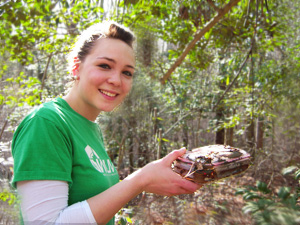AV's Intern Team | June 9, 2010 | No Comments

Space cadet holds up treasured cache. Photo by Map Man
Space Cadet reads out the clues of the cache. While Zergle decodes the hidden message, Map Man checks the GPS.
“We should be right on top of it,” Map Man says.
Space Cadet scans the area as Zergle pauses to think. Where could the cacher have hidden the treasure? The hunt begins.
After a long search, Zergle sits on a log to ponder the guides our cacher had given us. Suddenly his eyes light up as he recites the clue, “So many times have I sat on this bench, little did I know it was right beneath my… nose.” He reaches beneath the log and his fingers close in on a pencil box.
Geocaching is an international treasure hunting game that uses GPS coordinates as a map to the plunder, or cache. From books to bouncy balls, the treasure varies as widely as the hunters.
These treasure chests come in all forms; pencil boxes filled with assorted riches hidden on branches or underneath rock piles. A microcache may be as simple as a tiny canister magnetically gripping the bottom of a railing, often so small that they might only fit a rolled up piece of paper, a registry for successful hunters. Geocachers sign the log with their trail names, like the ones we chose–Space Cadet, Zergle and Map Man. It is up to the person who designs the cache to devise the treasure chest.
We used Geocaching.com , a central database for registering and locating caches, to identify the cache we wanted to hunt. In the late 1990s, web developer Jeremy Irish tried his hand at geocaching, and was so thrilled by his first caching expedition that he decided to unite his new hobby with his current skills, launching Geocaching.com in September 2000. Now, fellow treasure hunters can simply type in their zip codes and access information to hundreds of caches in their region. Cachers also use this site to register new caches, update their own caching list, or share tales of their quest for the cache.
In order to prepare for our endeavor, we needed to locate a cache to hunt. We talked about what type of hike we wanted to do—long or short, strenuous or easy, or even a “park and grab.” We selected a long, moderately strenuous hike.
Since this was our first adventure, we selected a lower graded cache–one considered easier to find–to familiarize ourselves with the geocaching process.
Map Man researched and printed out the clues for our first cache. He loaded the GPS coordinates to guide us to the treasure hunting search area. (For an added challenge, try geocaching without a GPS!)
A little bit of research goes a long way in your quest for the cache. Local maps provide detailed information of any terrain obstacles you may encounter, such as steep elevations and waterways, helping you determine the best route to reach your cache.
For your own safety, know your surroundings and bring navigational aids, to avoid becoming lost while searching for the hidden item. Marking your starting position as a waypoint on your GPS can help you navigate back from your hunt.
The greatest challenge arises as we close in on our cache. As we discovered, GPS coordinates only narrow down the location; they do not pinpoint the exact position of the treasure.
Once we arrive at our waypoint where the cache is located, we have to think like treasure hunters, keeping a keen eye out for things that seem unnaturally placed. The cache will not be buried, we know that much, but it could be placed anywhere- -in or under a log, on a tree branch, in a bucket, or even in plain sight.
Oftentimes, registered caches will have additional clues. Tips like “Eat Outside” or “Guarded…watch your step!!!” may seem vague, but once you arrive at the site of the cache, they can help you decipher the puzzle. For example, guarded could infer that the cache is hidden in a guardrail or eat outside might tip you off to look for a picnic table.
Opening the pencil box, Zergle pulls out a glittery snowman pin, a ladybug button, a hackey sack and the registry log. Unrolling the scroll, he inscribes our names beside the date as successful seekers of this loot. As custom dictates, we trade one of our treasures for one of the cache’s riches— a turtle toy for a hackey sack.
Closing the cache, we restore it to its hiding spot, exactly as we had found it.
And happily, with our prize in pocket, our motley band of treasure hunters treks back the way we had come.
When we return home from our expedition, we log on to the cache page on Geocaching.com to note the details of our quest so that other cachers can revel in our victory and plot their own excursions to find the cleverly hidden cache.
Like this content? Subscribe to The Voice email digests